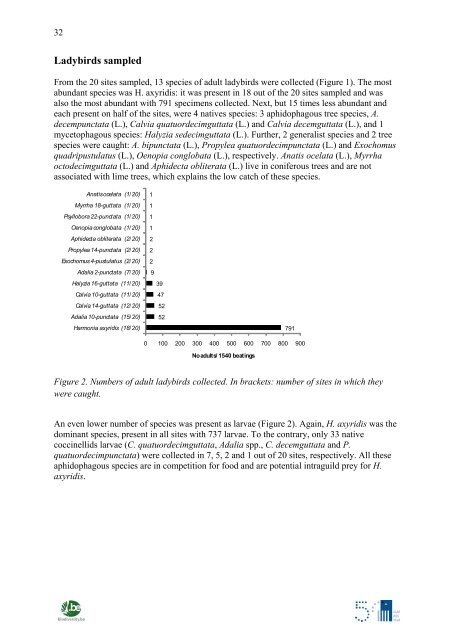Science Facing Aliens - Invasive Alien Species in Belgium - Belgian ...
Science Facing Aliens - Invasive Alien Species in Belgium - Belgian ...
Science Facing Aliens - Invasive Alien Species in Belgium - Belgian ...
Create successful ePaper yourself
Turn your PDF publications into a flip-book with our unique Google optimized e-Paper software.
32<br />
Ladybirds sampled<br />
From the 20 sites sampled, 13 species of adult ladybirds were collected (Figure 1). The most<br />
abundant species was H. axyridis: it was present <strong>in</strong> 18 out of the 20 sites sampled and was<br />
also the most abundant with 791 specimens collected. Next, but 15 times less abundant and<br />
each present on half of the sites, were 4 natives species: 3 aphidophagous tree species, A.<br />
decempunctata (L.), Calvia quatuordecimguttata (L.) and Calvia decemguttata (L.), and 1<br />
mycetophagous species: Halyzia sedecimguttata (L.). Further, 2 generalist species and 2 tree<br />
species were caught: A. bipunctata (L.), Propylea quatuordecimpunctata (L.) and Exochomus<br />
quadripustulatus (L.), Oenopia conglobata (L.), respectively. Anatis ocelata (L.), Myrrha<br />
octodecimguttata (L.) and Aphidecta obliterata (L.) live <strong>in</strong> coniferous trees and are not<br />
associated with lime trees, which expla<strong>in</strong>s the low catch of these species.<br />
Anatis ocelata (1/20)<br />
Myrrha 18-guttata (1/20)<br />
Psyllobora 22-punctata (1/20)<br />
Oenopia conglobata (1/20)<br />
Aphidecta obliterata (2/20)<br />
Propylea 14-punctata (2/20)<br />
Exochomus 4-pustulatus (2/20)<br />
Adalia 2-punctata (7/20)<br />
Halyzia 16-guttata (11/20)<br />
Calvia 10-guttata (11/20)<br />
Calvia 14-guttata (12/20)<br />
Adalia 10-punctata (15/20)<br />
Harmonia axyridis (18/20)<br />
1<br />
1<br />
1<br />
1<br />
2<br />
2<br />
2<br />
9<br />
39<br />
47<br />
52<br />
52<br />
791<br />
0 100 200 300 400 500 600 700 800 900<br />
No adults/ 1540 beat<strong>in</strong>gs<br />
Figure 2. Numbers of adult ladybirds collected. In brackets: number of sites <strong>in</strong> which they<br />
were caught.<br />
An even lower number of species was present as larvae (Figure 2). Aga<strong>in</strong>, H. axyridis was the<br />
dom<strong>in</strong>ant species, present <strong>in</strong> all sites with 737 larvae. To the contrary, only 33 native<br />
cocc<strong>in</strong>ellids larvae (C. quatuordecimguttata, Adalia spp., C. decemguttata and P.<br />
quatuordecimpunctata) were collected <strong>in</strong> 7, 5, 2 and 1 out of 20 sites, respectively. All these<br />
aphidophagous species are <strong>in</strong> competition for food and are potential <strong>in</strong>traguild prey for H.<br />
axyridis.


